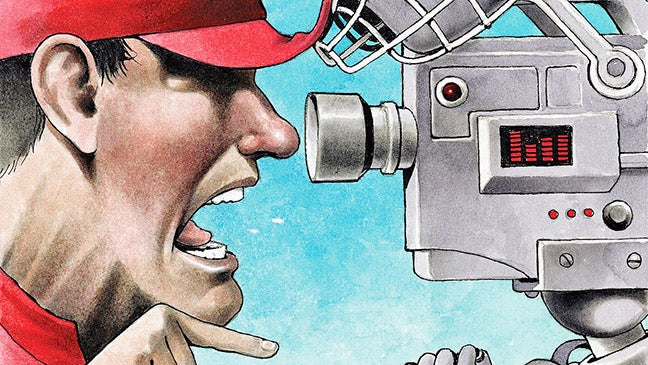Robot umpires debut in independent Atlantic League
Published 12:42 am Thursday, July 11, 2019

Doug Griswold illustration of a baseball manager arguing with a robotic umpire. (Bay Area News Group/MCT)
YORK, Pa. (AP) — “Robot umpires” have arrived.
The independent Atlantic League became the first American professional baseball league to let a computer call balls and strikes Wednesday night at its All-Star Game.
Plate umpire Brian deBrauwere wore an earpiece connected to an iPhone in his pocket and relayed the call upon receiving it from a TrackMan computer system that uses Doppler radar.
He crouched in his normal position behind the catcher and signaled balls and strikes. It didn’t appear he had any delay receiving the calls in the first inning.
“Until we can trust this system 100 percent, I still have to go back there with the intention of getting a pitch correct because if the system fails, it doesn’t pick a pitch up or if it registers a pitch that’s a foot-and-a-half off the plate as a strike, I have to be prepared to correct that,” deBrauwere said before the game.
The umpires have the ability to override the computer, which considers a pitch a strike when the ball bounces and then crosses the zone.
TrackMan also does not evaluate check swings.
About 45 minutes before first pitch, the public address announcer directed fans to look up at the black screen hanging off the face of the upper level behind the plate and joked they could blame the computer for any disagreements over calls.
“This is an exciting night for MLB, the Atlantic League, baseball generally,” said Morgan Sword, MLB’s executive vice president of economics and operations.
“This idea has been around for a long time and it’s the first time it’s been brought to life in a comprehensive way.”
The experiment with radar-tracking technology to call balls and strikes was originally expected to begin at the start of the season but experienced some delays.
Atlantic League President Rick White said it’s going to be implemented league-wide over the next few weeks.
“After that, we’re relatively confident that’s it’s going to spread through organized baseball,” White said.
“We’re very excited about what this portends not only for our league but for the future of baseball.
“What we know is technology can help umpires be more accurate and we’re committed to that. We think the Atlantic League is being a pioneer for all of the sport.”
Sword said MLB hasn’t received much pushback from umpires.
“One of our focuses is not to replace the umpire,” Sword said. “In fact, we’re trying to empower the umpire with technology. The home plate umpire has a lot more to do than call balls and strikes and he’s going to be asked to do all of that. We’re in touch with our umpires union and this is the first step of the process.”
DeBrauwere had no issue with it.
“This is just another plate job and I just get a little help on this one so I feel very relaxed going into this one,” he said.
Strike zones are determined according to the average for players of that height unless there’s already information on a player’s particular strike zone if they’ve played in the majors at some point.
“It’s too early to say and no decisions have been made about our plan,” Sword said about a timeline for use in the major leagues. “Our directive here is to create a system that works.”

